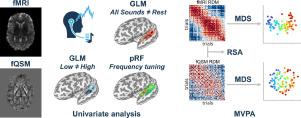NeuroImage ( IF 5.7 ) Pub Date : 2021-09-08 , DOI: 10.1016/j.neuroimage.2021.118574 Marta Lancione 1 , Mauro Costagli 2 , Giacomo Handjaras 3 , Michela Tosetti 4 , Emiliano Ricciardi 5 , Pietro Pietrini 5 , Luca Cecchetti 3

|
Functional Quantitative Susceptibility Mapping (fQSM) allows for the quantitative measurement of time-varying magnetic susceptibility across cortical and subcortical brain structures with a potentially higher spatial specificity than conventional fMRI. While the usefulness of fQSM with General Linear Model and “On/Off” paradigms has been assessed, little is known about the potential applications and limitations of this technique in more sophisticated experimental paradigms and analyses, such as those currently used in modern neuroimaging.
To thoroughly characterize fQSM activations, here we used 7T MRI, tonotopic mapping, as well as univariate (i.e., GLM and population Receptive Field) and multivariate (Representational Similarity Analysis; RSA) analyses.
Although fQSM detected less tone-responsive voxels than fMRI, they were more consistently localized in gray matter. Also, the majority of active gray matter voxels exhibited negative fQSM response, signaling the expected oxyhemoglobin increase, whereas positive fQSM activations were mainly in white matter. Though fMRI- and fQSM-based tonotopic maps were overall comparable, the representation of frequency tunings in tone-sensitive regions was significantly more balanced for fQSM. Lastly, RSA revealed that frequency information from the auditory cortex could be successfully retrieved by using either methods.
Overall, fQSM produces complementary results to conventional fMRI, as it captures small-scale variations in the activation pattern which inform multivariate measures. Although positive fQSM responses deserve further investigation, they do not impair the interpretation of contrasts of interest. The quantitative nature of fQSM, its spatial specificity and the possibility to simultaneously acquire canonical fMRI support the use of this technique for longitudinal and multicentric studies and pre-surgical mapping.
中文翻译:

在现代神经影像学研究中用功能性定量磁化率映射 (fQSM) 补充规范 fMRI
功能定量磁化率映射 (fQSM) 允许对皮质和皮质下大脑结构的时变磁化率进行定量测量,其空间特异性可能比传统 fMRI 更高。虽然已经评估了具有通用线性模型和“开/关”范式的 fQSM 的有用性,但对该技术在更复杂的实验范式和分析中的潜在应用和局限性知之甚少,例如目前用于现代神经成像的那些。
为了彻底表征 fQSM 激活,我们在这里使用了 7T MRI、音调映射以及单变量(即 GLM 和总体感受野)和多变量(代表性相似性分析;RSA)分析。
尽管 fQSM 检测到的色调响应体素比 fMRI 少,但它们更一致地定位于灰质。此外,大多数活跃的灰质体素表现出负 fQSM 反应,表明预期的氧合血红蛋白增加,而正 fQSM 激活主要在白质中。尽管基于 fMRI 和 fQSM 的音调图总体上具有可比性,但 fQSM 对音调敏感区域的频率调谐表示明显更加平衡。最后,RSA 揭示了来自听觉皮层的频率信息可以通过使用任一方法成功检索。
总体而言,fQSM 产生了与传统 fMRI 互补的结果,因为它捕获了激活模式中的小规模变化,从而为多变量测量提供了信息。尽管积极的 fQSM 反应值得进一步调查,但它们不会影响对兴趣对比的解释。fQSM 的定量性质、其空间特异性和同时获得规范 fMRI 的可能性支持将该技术用于纵向和多中心研究以及术前映射。



























 京公网安备 11010802027423号
京公网安备 11010802027423号